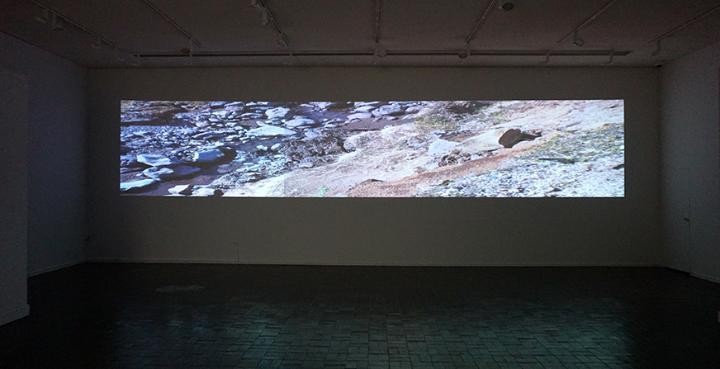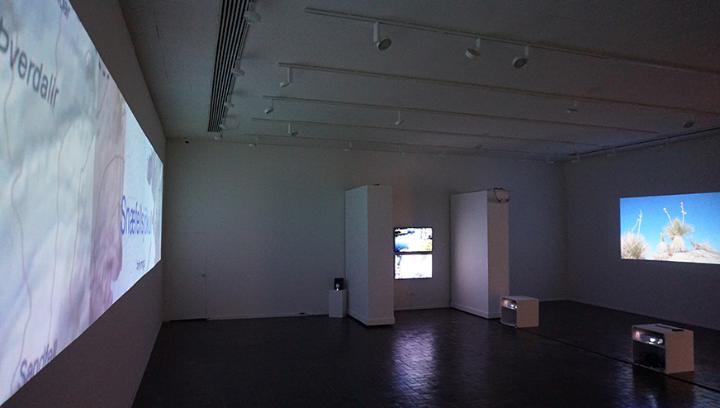Peter d’Agostino: COLD / HOT - Walks, Wars & Climate Change

August 27 - November 3, 2018
Public Reception: Wednesday September 12, 5 – 6:30pm
Public Talk: Peter d’Agostino: Monday September 17, 5pm, in the Recital Hall, Baker Center for the Arts
Martin Art Gallery, in the Philip Johnson designed Baker Center for the Arts
Muhlenberg College, Allentown, PA.
Contact: Paul M. Nicholson, Gallery Director
This exhibition focuses on the theme of COLD / HOT as it relates to walks, wars and climate change, drawing from a selection of Peter d'Agostino's work, in particular his World-Wide-Walks / between earth & water installations, ICE / DESERTS / WETLANDS.
D'Agostino has performed the Walks on six continents over the past five decades. Initiated as video 'documentation/performances' in 1973, the Walks evolved into video/web projects in the 1990s and mobile/locative media installations in the 2000s, probing and examining climate change during the last decade. World-Wide-Walks explore natural, cultural, virtual identities: mixed realities of walking through physical environments and virtually surfing the web.
As a key to the thematic content of this exhibition, recent Walks performed with 360- degree VR video cameras serve to bridge d'Agostino's use of new media technologies with an earlier work, VR/RV: a Recreational Vehicle in Virtual Reality (1993-94). Portraying simulations of armed conflicts in Asia and the Middle East as a fully immersive interactive virtual reality project with an HMD (head-mounted display) and data gloves, VR/RV appears in this exhibition as a video installation.
In the Anthropocene era, walks, wars, and climate change, as observed on glaciers, wetlands and deserts, become sites of accelerated and enflamed transition, potential zones of stress and conflict. In 2007, the Intergovernmental Panel on Climate Change (IPCC), a team of scientists from around the world, confirmed initial indications that human activity caused the Earth's rising temperature.
In Climate Change and Armed Conflict, James R. Lee identifies the resultant symptoms of climate change stress and conflict: loss of arable land, migration, border disputes, resource shortages and shifting energy supplies. Exacerbating the situation, the growing population and proliferation of human civilization across the globe has diminished drastically the reservoir of untapped lands (historically a "pressure valve"). Of those untapped lands remaining, marginal areas like the Arctic and Antarctica might become more habitable leading to even greater conflict for land and resources.
(Lee, 2009, p.6).
Peter d'Agostino's pioneering photography, video and new media projects have been exhibited internationally in the form of installations, performances, telecom events, and broadcast productions for over four decades. He is the recipient of a Leonardo Art & Climate Change project award, 2010-11. Surveys of his work include: World-Wide-Walks/ between earth & sky / 1973- 2012, BizBAK Art Gallery, Bilbao, Spain; Between Earth & Sky: MX (1973-2007), exhibited at Laboratorio Arte Alemeda, Mexico City; Between Earth & Sky, 1973/2003, University of Paris I Pantheon-Sorbonne; Interactivity and Intervention, 1978-99, Lehman College Art Gallery, New York. Major group exhibitions include: The Whitney Museum of American Art (Biennial, and The American Century -Film and Video in America 1950-2000), the Sao Paulo Bienal, Brazil, and the Kwangju Biennial, Korea. His works are in the collections of The Museum of Modern Art, New York, San Francisco Museum of Modern Art, Berkeley Art Museum / Pacific Film Archive, Kunsthaus, Zurich, Foundation La Caixa, Barcelona, Spain; and distributed by Electronic Arts Intermix, NY.
Works in the exhibition are accompanied by a 40 page catalogue
World-Wide-Walks / between earth & water / ICE (2012-14)
Walks along the edge of glaciers, at the top and bottom of the globe in Iceland, Alaska and Argentina witness signs of global warming. Juxtaposed with the walks and a sound score of evolving glacial dynamics are cautionary texts that serve as a counterpoint to the sheer beauty of these places- reminders of the fragility of massive glaciers during our current era of accelerating climatic changes.
World-Wide-Walks / between earth & water / DESERTS (2011-18)
Walks in the four major desert areas of North America. The Chihuahuan Desert includes: Soaptree Yucca plants, fields of petroglyphs, the location of the first Atomic Bomb detonated in 1945 preceding Hiroshima and Nagasaki, as well as the U.S./ Mexico border separating the sister cities of El Paso
and Juarez. [ In-progress: Mojave, Sonoran, and Great Basin deserts.]
World-Wide-Walks / between earth & water / WETLANDS (2010-18)
Walks focusing primarily on the Florida Everglades and Cuba's Zapata Swamp provide important insights into the effects of the changing climate and issues related to cold / hot wars. The Zapata preserve is adjacent to Cuba’s Bay of Pigs, where the failed invasion led to the most dramatic and dangerous incident of the Cold War - the Cuban Missile Crisis in October 1962.
VR / RV: a Recreational Vehicle in Virtual Reality (1993-94)
VR/RV explores the displacement and disembodiment of a technologically determined culture which co-mingles video games and computerized war. Reconstructed scenes from the atomic bombing of Hiroshima in 1945 are juxtaposed with ‘smart bombs’ used in the Gulf War, 1990-91.



